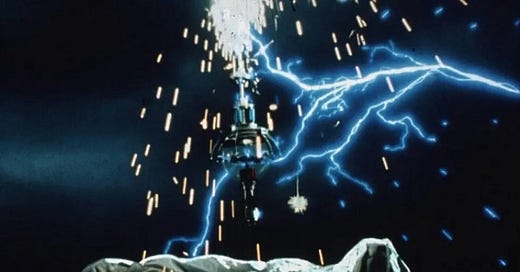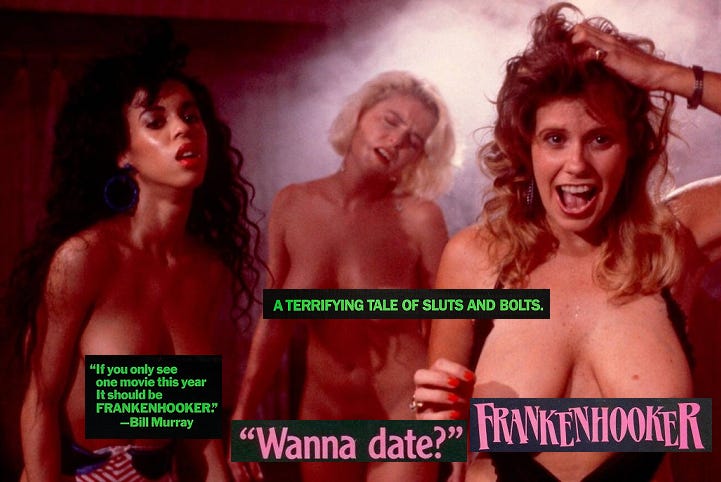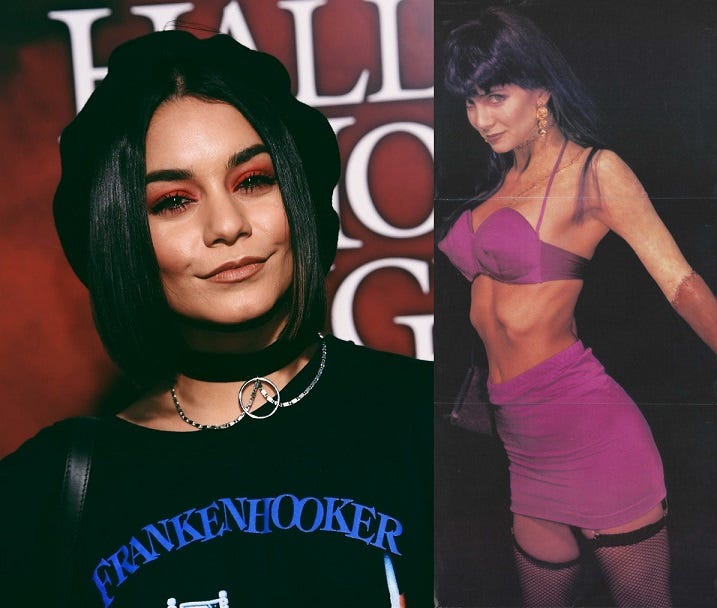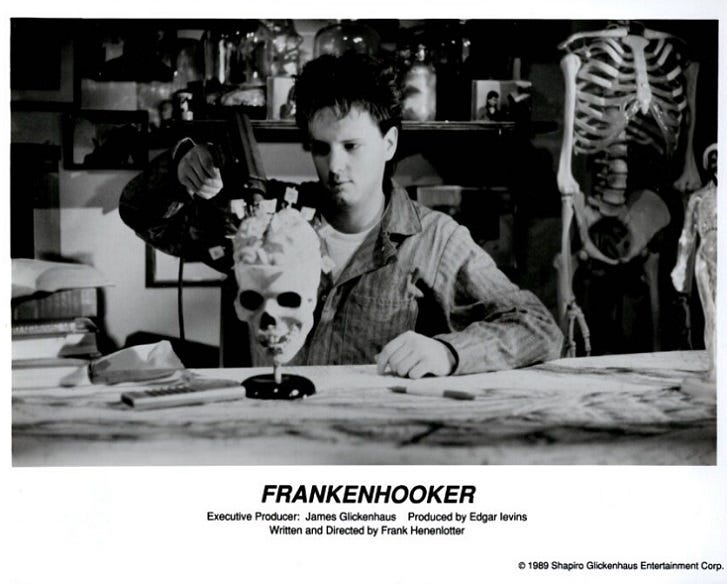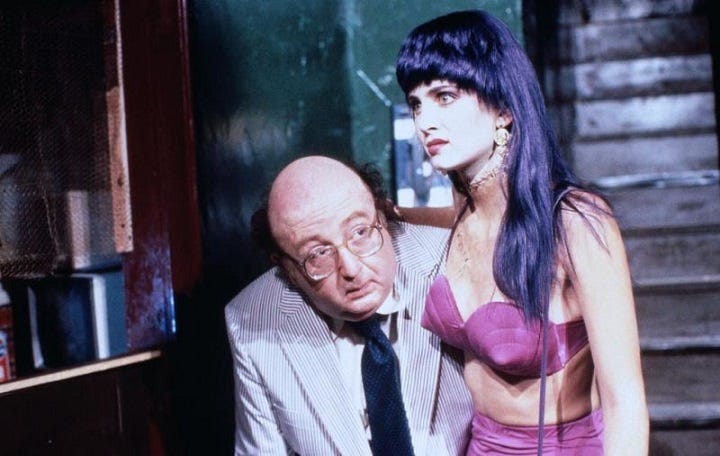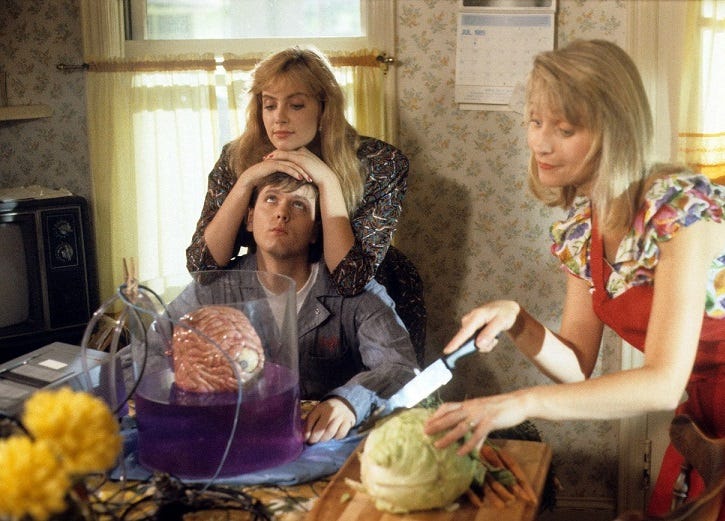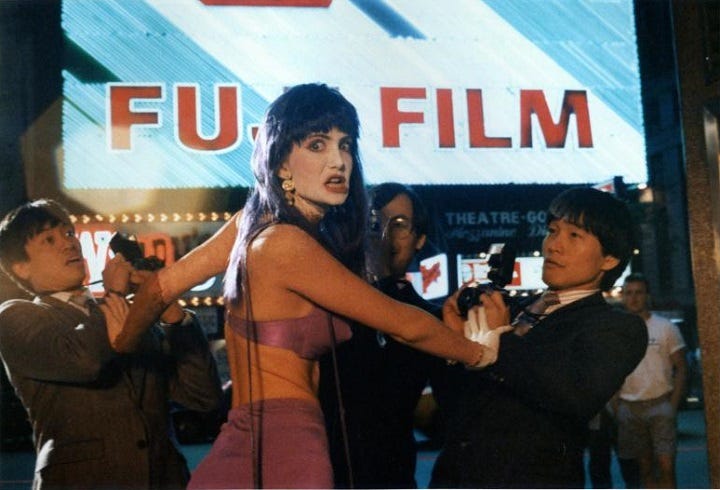Frankenstein 90 (1984) is a French film. It was also the working title of Frankenhooker (1990), give or take the apostrophe. Pygmalion, the 1912 novel, is what the latter film could have been like. But then the same thing could be said about Weird Science (1985). The stigma of making a film called Frankenhooker could have been sidestepped by using a variant of the original title used in Mary Shelley’s 1818 novel - Frankenstein; or, The Modern Prometheus. This could have been achieved by creating some kind of portmanteau of prostitute and prosthetic or by making a film about a high school prom, especially since the eighties was the ultimate decade for teenage makeover movies. Speaking of portmanteaus, the title of my article combines two French terms for prostitutes.
Seeing as how William Shatner was in a TV series called T.J. Hooker which ended in 1986, director and co-writer Frank Henenlotter could have made a film called T.A. Hooker (T&A means tits and ass). You may think that there would have been a copyright issue but Frankenhooker began filming in the exact same month as Brian Yuzna’s Bride of Re-Animator - i.e. June 1989. Frankenhooker was second to start and finish. In one of the below stills, you can see a calendar which shows the month to be July of that year. The Frank Henenlotter film could have been better, especially since it was released in the same year as Pretty Woman.
From a modern perspective, a feminist remake of Frankenstein with elements of Pygmalion would be a commentary on mansplaining. But then that’s why we have the Yorgos Lanthimos film, Poor Things. The difference is that, as famous as Emma Stone is, there won’t be as much cosplay based on her like with Frankenhooker nor will an actress like Vanessa Hudgens be seen wearing a shirt advertising Poor Things like she did with Frankenhooker. Even back in 1990, a lot of messages could have been delivered about the pointlessness of plastic surgery and the overlooked employment of body doubles used in films (including the aforementioned Pretty Woman). In the case of Frankenhooker, even religious meaning could have been imparted. God was said to have made man in the image of himself, but it appears that male filmmakers like to cast women be an extension of their imaginations.
This is where men may have missed their calling with the voodoo genre of films, especially with the gimmick of a hypnotist competing with a voodoo priest. Many men love manipulating women, and writing a screenplay is almost like writing a love letter. The film in the can is the message in the bottle. In the case of Frankenhooker, it makes the case that if you can’t find an actress to get naked in a union movie then get strippers to join the SAG union. In a non-union U.S. movie like Enter the Dragon, escorts were hired to play prostitutes because no Hong Kong actresses were willing to lower themselves. Make no mistake about it, the casting couch has been used in Hong Kong. Casting adult entertainers is a cheaper solution than simultaneously casting a mainstream actress and a body double. Since Frank Henenlotter was willing to cast Penthouse model Patty Mullen, he may as well have thought about casting her lookalike: ex-p*rn star Traci Lords.
Frankenhooker is a clunky title. A better one would have been Lady of the Nightmare, or even Turning Tricks and Treats. At any rate, film-maker Frank Henenlotter deserves credit for being more racially inclusive with his babe casting than someone like Jim Wynorski. When I first found out about the film, I was thinking that the parable would be even better served if updating Robert Louis Stevenson’s Strange Case of Dr. Jekyll and Mr. Hyde (1886). That novel was a couple of years before Jack the Ripper started killing prostitutes. Back in those days, nobody thought of copycat killers but I can imagine someone being inspired by the novel to create a dual persona. Stalking Stockings would have been a good title had that plot angle been pursued. The 2017 Beauty and the Beast remake would have been better if the story was Eliza Doolittle meets Dr. Jekyll - two people undergoing transformations except the man doesn’t know about the woman’s guise.
The Frankenstein and makeover genres (including films about training for combat) appeal because they literally sell the concept of reinventing oneself. You don’t even need product placement to hawk (Frankenhawker is another contender for a title), especially when you have shills. Robert Martin, co-writer of Frankenhooker, was the editor of Fangoria magazine. This makes you think about how magazines can be objective when the writers go on to make movies, as was the case with Christophe Gans. I guess the only guarantee for a bad review to be written would be if there was any bad blood between workers of a magazine. The Mad Movies magazine cornered the market for horror in France, edging out Fangoria. In the March 1990 issue (#64) of Mad Movies, it was relayed by producer Edgar Levins that Frank Henenlotter’s Basket Case 2 and Frankenhooker were made back to back. Both men had previously been working on another project. Edgar said: “But Frank had written a script that was considered too scary. That really bothered us. Imagine being told that your comedy is too hilarious.”
Realistically speaking, a script that is too scary is one where the line is blurred between sex and violence. For example, a slasher movie about a killer who enjoys sexual harassment. Anyway, the combined cost of the two consecutive productions was said to be five million dollars. Edgar also said: “We were able to achieve things that were impossible in the past. Our association is like a perfect marriage. My responsibility is mainly to create an environment where Frank can film. It's good to have a real budget to manage, and a fairly healthy work plan. Basket Case 2 will not be gory like the previous one simply because times have changed. Frank's energy, his vision as a filmmaker, and also a more comfortable budget, allow Basket Case 2 to surpass the first one head and shoulders.”
Director James Glickenhaus was mentioned in the article since he ran the company known in brief as SGE: Shapiro Glickenhaus Entertainment. Referred to as the other producer on the film, James heard Frank Henenlotter’s Frankenhooker pitch and said: “Great. And do you have anything else?”
Frank said: “Yes, there's always Basket Case 2.”
James immediately asks the filmmaker to write him a synopsis, which he does in parallel with the writing of Frankenhooker. Two days after the texts were submitted, James gave his approval. Basket Case 2 was immediately filmed after Frankenhooker. The original Basket Case contained a scene where the protagonist was watching Enter the Dragon in a cinema.
When talking to Marc Toullec for Mad Movies magazine, Frank said: “The SGE company offered me what no other company wanted to give me, namely total control over what I was doing and a budget higher than forty cents.”
In 1984, James Glickenhaus had directed a Jackie Chan movie called The Protector. James remembered that Jackie was shooting two other movies at the same time, so he knew that multitasking could be done. The Protector had ample nudity in a scene involving women working in a drugs lab. Frankenhooker had a drugs plot device but nothing to the level of the JC movie that was partially filmed in Hong Kong. James clearly had nothing against casting Oriental women as eye candy, hence Lia Chang in Frankenhooker (as seen above). JC made his own version of Pygmalion - Miracles (1989).
In the January 1991 issue (#69) of Mad Movies, there was an interview with Frank Henenlotter. He was asked why he decided to do a Basket Case sequel besides money. He said: “It wasn't a money issue. I actually made a kind of deal with SGE, the company that was really keen to make a sequel to Basket Case. I said, "I'll make you this sequel if you let me make another movie." I was having a really hard time getting enough money together for a new project.”
Frank was asked if Frankenhooker was more important to him than Basket Case 2 (a sequel to a film that contained a music cue which was later heard in a Sammo Hung film called The Victim). Frank said: “No, but I still prefer to invent new characters rather than recycle old ones. Obviously, Basket Case is a compromise and I'm trying to work with it. SGE is currently asking me for a Basket Case III. Which will allow me, by dealing, to make another film. I still hope that, in ten years, I won't be here talking to you about Basket Case XXXXIII. No way. I'll have slit my throat long before that!”
Frank was informed that quite a few people hated the first one yet love the second one. He said: “Basket Case II is a pretty nice movie. It's not wild, it's not completely crazy. It's a very comic book horror movie.”
The Frankenhooker casting process: “I had a hard time finding the girls. Frankenhooker is a very official production, so I could only use union actors. And in New York, it's not as easy as it is in Los Angeles to find pretty union actresses who are happy to go topless on screen. So I had the idea of contacting models from Playboy and Penthouse. Patty Mullen, who plays Frankenhooker, is a Penthouse model from '89. She's both very beautiful and very funny. She has incredible comedic talent.”
Frank was asked if the idea of the nervous grin came from him. He said: “No, that's one of her many talents. She kept making me laugh on set. You can even hear my laughter on the soundtrack of the film. You can't erase it. I also had two other Penthouse Pets - a Playmate of the Year, and a Swedish girl who is very famous in New York. Her real name is Gitan Godding, but she is better known by her stripper name - Bibie. She was very happy to do Frankenhooker. There was also Heather Hunter, who has since become a p*rn actress in about fifteen films.”
The irony of casting desirable women for limited screen time: “Ah, aaah, aaaaah... I gathered all the girls together to explain to them what it was about. "So you see, you take off your clothes, you smoke crack, and you explode." And, one after the other, they answered: "Ok", "Sure", "No problem", "Let's go"! I told them, anyway, to take the script home and read it, but no one did. They didn't care. They liked the idea, they thought it was funny!”
Problems with the special effects for the signature scene: “Money problems first. Frankenhooker is my biggest budget, $1.7 million, which is the budget for supplies on a normal film! Fortunately, it was the third time I worked with Gabe Bartalos, after Brain Damage and Basket Case 2. He knows the budget restrictions and is very ingenious. The less money you give him, the more he finds ways to create crazy effects. I love the monsters he designed on Basket Case 2. They are incredible. Okay, to get back to this scene, there were a lot of body parts scattered all over the room. One morning, I arrive on set and a lot of legs were missing. We had rubber legs stolen! The thief was probably part of the crew. I wonder what the hell he did with the rubber legs. Or rather, I prefer not to think about what he did with them, like start talking to them while salivating, ugh... The annoying thing is that we still had scenes to shoot with these legs and we had to get super stiff legs from plastic mannequins. Funny way to make a movie, but when you don't have any money, you have to have ideas.”
Speaking of mannequins, James Lorinz looks like Andrew McCarthy - who was in Mannequin (1987). It’s about a man who falls in love with a mannequin who comes to life. Back to Mad Movies, Frank Henenlotter was asked if he likes New York. He said: “I love New York. It's probably the place on the planet where I feel the best. It's a horrible, dirty, dangerous city. You sometimes witness burglaries, fights, even real assaults...”
He is asked if he still goes out in the evening: “Yes, of course. I know New York very well and I know when to run. If I have one piece of advice to give to someone who arrives in New York, it is to arm themselves with a weapon. That said, I can't help but have affection for New York.”
His films don't give a very welcoming image: “The bar in Frankenhooker is real. I know it, I even go there often. It's the kind of place where they lock the door at night and only let in those they know. The clientele is made up of junkies, killers, whores, pimps, transvestites... The owners had given me permission to film inside the bar. Unfortunately, it closed three months before filming. So we built sets inspired by this bar.”
Frank always had money problems with his films: “I don't shoot A-list films, and B movies tend to disappear in the USA. So it's getting harder and harder to make this kind of film. Just a few years ago, B movies were being picked up by the bucketload, money was pouring in without any controls on the shooting. Today, the only productions that are being made without problems are sequels. It's terrible. I've never really known how to get out of it. I recently hired an agent to find me bigger budgets or original A-list films. And if I don't get any help from that side, I'll quit this job!”
After Basket Case III (1991), his next film was Bad Biology (2008). Frank is told by Vincent Guignebert that he is better than some directors who have big budgets: “I have scripts that have been rejected by everyone. One was a movie with insects. I sent it to my agent and he loved it. He told me he laughed from page 1 to page 94. He also told me he would be p!ssed if I had never written that, that he had never read anything that filthy, that he would be unable to get anyone to read it. So there you have it. Every year, I have half a dozen projects in this style or that of Frankenhooker, and I think I will never finish them if I don't make Basket Cases.”
Vincent suggested getting Steven Spielberg. Frank said: “Call him! Or give me his phone number! I can't even approach this guy. I don't know anyone in the business, anyone in the Majors. That's why I got an agent. I told him: "Go for it!" And I'm sure he's going for it, huh. I'm even sure he must be looking up the phone numbers of the Majors in the yellow pages! Let's hope he never reads this interview...”

